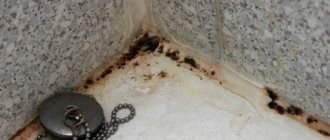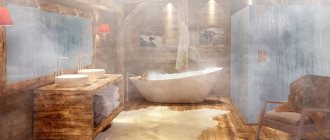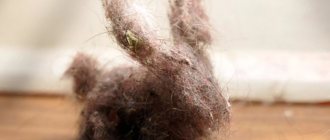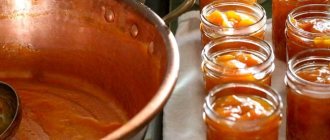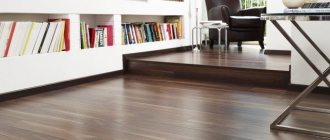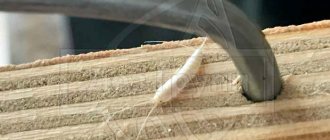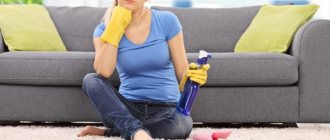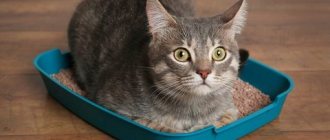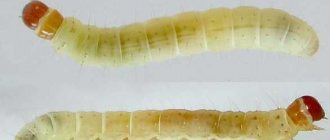The presence of mold on the walls is typical not only for old houses, but also for new buildings. The black spots that appear on the wallpaper do not decorate the apartment at all and cause significant harm to health. When the first black spots are detected, you should immediately begin to fight mold. This article describes in detail the causes of blackening, discusses the types of household mold, as well as methods for preventing and combating formations on wallpaper.
What it is?
Attention
Mold is a colony of toxic single-celled fungi. The presence of a favorable environment contributes to the rapid reproduction of spores.
Types of household mold:
- Green mold . Least aggressive. It can be quickly removed with cleansing agents.
- Dark green mold under the wallpaper . Timely detection allows you to get rid of it with fungicides.
- White mold . Outwardly it looks like a bunch of fluff or feathers. It spreads quickly in hard-to-reach and inconspicuous places, so it is detected late. Due to its toxicity, it is dangerous to humans, so processing should be carried out with a respirator and gloves.
- Black mold . The most dangerous, causes acute inflammation, asthma attacks, bronchitis, and cancer. It spreads quickly and affected surfaces require complete replacement and repair. Can be removed with chemicals and thorough cleaning.
Fungal spores enter the human body by air . Mold poses the greatest danger to pregnant women, young children, and people with reduced immunity. As a result of hazardous exposure:
- general health deteriorates sharply;
- constant headache;
- acute allergic reactions develop;
- diseases of the respiratory system appear.
If more than 20% of the entire area is affected by mold, we are talking about massive contamination of housing, which is unsuitable and dangerous for further residence of people and pets.
Wall covering type
Before we begin getting rid of mold, we determine whether the damage has grown to the extent of the plaster. To do this, it is recommended to find the place that has darkened the most and tear off a piece of the coating. If the plaster underneath is crumbly and wet, then the fungus has damaged it, and you will have to tear off the wallpaper and thoroughly treat the wall. If it is not damaged, then you can simply clean the stains on the surface using traditional methods or special means.
Paper wallpaper
If paper wallpapers have been damaged, it is easier to replace them with new ones, because they cannot be wet. When this is not possible, you can remove the blackness using the dry method.
First, it is recommended to dry the wall material; this can be done using a hair dryer or iron. Then, using a soft brush, remove the fungus under the wallpaper. If the finishing material has come off, then the wall must be brushed, then glued and ironed. If the work is carried out correctly, you can get rid of this problem forever.
Non-woven or acrylic wallpaper
This type is moisture resistant, so you can get rid of stains without repair. But, only if the primer or inner surface was not damaged.
Causes of fungus
Factors contributing to the rapid development of mold fungi include::
- High humidity.
- Lack of ventilation. If there is no influx of fresh air, pathogenic microorganisms develop unhindered.
- Furniture moved close to the walls, which disrupts natural air circulation.
- Lack of insulation. If the construction process is disrupted, the floors have no or insufficient waterproofing, sudden temperature changes in the walls in autumn and winter have a beneficial effect on the rapid proliferation of fungal spores.
- Dampness in the basement or poor roof insulation. Most people living on the first and last floors of apartment buildings often encounter mold.
AdviceLeaking floors, roofs, and damp basements are an ideal environment for the growth of mold fungi.
Mold under the wallpaper appears immediately after repairs are carried out if:
- Building materials that were already contaminated or of poor quality were used. Often this is plasterboard, since pathogenic microorganisms are perfectly preserved in the layered structure.
- Metal-plastic windows with increased tightness were installed.
- The craftsmen made mistakes during the repair work. When gluing new wallpaper onto wet plaster or putty, after some time you can detect pockets of pathogenic microorganisms.
What to do and how to get rid of the smell and black spots?
If fresh traces of mold are discovered, you must first eliminate the cause of their appearance. To stop further spread you must:
- Saturating the room with sunlight and fresh air.
- Installation of a forced ventilation system.
- Ensuring the flow of warm, dry air (+20…+23 degrees) using electric heating devices.
After eliminating sources of dampness, frequent wet cleaning with antibacterial agents will be required.
To further combat the “uninvited guest” you will need the following tools:
- special solution for destroying pathogenic microorganisms;
- antiseptic solution;
- gloves;
- respirator;
- putty knife;
- sandpaper;
- sponges.
- First you need to get rid of the old wallpaper and clean the walls (find out how to remove liquid wallpaper, photo wallpaper, washable wallpaper, including from drywall). Loose plaster is completely removed.
- Afterwards, the walls are carefully treated with sandpaper, paying special attention to the affected areas.
- The walls are treated with a special anti-mold agent. After a few hours, the procedure is repeated.
- It is best to carry out five treatments and then prime the walls with an antiseptic solution. Then you can plaster, putty and stick new wallpaper (read about how to distinguish different types of wall covering and determine which is better here).
Important
If all requirements are met, mold will not reappear.
Room treatment
What do we do? Choose the appropriate solution method! If your intention to get rid of mold is serious enough, then there is a whole range of measures for its complete or, better yet, total destruction. If you can afford to treat a room or room affected by mold with ultraviolet light, then it is recommended that you do so.
The next thing you need to do to get rid of mold is to choose a special product that has all the properties we need. There are entire product lines, from putty and paint to anti-mold composition. It is recommended to pay attention first to such means. Firstly, because by applying such plaster to your walls, you will at least warn the mold that it is better not to come here. Plaster was applied and the walls were treated. Go ahead. Now it is recommended to use a stiff brush and be sure to go through all the walls that have already been treated once again while wearing a respirator. We remove everything that has fallen off the floor with a damp broom or rag with an alcohol solution. It is advisable to leave the room alone for several days and then carefully examine all the corners and crevices for the presence of mold formations. If they are not found, then you can congratulate yourself and start looking for new suitable wallpapers!
How can I clean it without tearing the wallpaper off the walls?
You can fight pathogenic microorganisms with chemical and folk remedies.
Chemical means
The range of good quality fungicides is sufficient to treat any surfaces in the apartment, even wallpaper (read about how to clean new wallpaper from stains and remove old ones from walls before renovation). The products are available for sale in hardware and construction stores.
Before use , you should study the instructions, carefully follow the recommendations and remember safety precautions . Due to their toxicity, some chemicals can be harmful to the health of humans and pets. The treatment must be carried out in protective clothing to avoid chemical burns or an acute allergic reaction.
Among the most effective means:
- Dali (Russia). Release form - containers with a volume of 5 liters. The product is universal; it can be used to treat any surface. Destroys mold, moss, and other manifestations of dampness.
- "Fongiflud Alpa" (Russia). Available in volumes of 2, 5 and 20 liters. Suitable for processing both indoors and outdoors. Antiseptic properties are preserved even at low temperatures.
- "Olympus stop mold" (Russia). Ideal for eliminating mold in bathrooms, living rooms, basements, and cellars. The product can be used to treat any surface.
- "Biotol spray" (Russia). Environmentally friendly antiseptic. Non-toxic, safe, it can be used in residential areas.
- Ftlas mykos (Poland). The main active ingredient is ammonia. Highly effective in destroying mold spores.
Folk remedies
To achieve results when using folk remedies, you need to carry out several treatments. Commonly available tools are often used:
- Baking soda is cheap, non-toxic, and suitable for washing mold off wallpaper. To prepare a soda solution, dissolve a teaspoon of soda in a glass of warm water. Moisten a soft sponge in the solution to remove the mold. Treated surfaces do not require additional rinsing with water. A fairly long-lasting result remains after treating rooms with this product.
- with table vinegar or pour it into a spray bottle and treat the affected walls. Allows you to easily remove most types of mold fungi. Upon completion of the treatment (after an hour), wipe all surfaces with a damp cloth; it is also necessary to thoroughly ventilate the apartment after the procedure.
- Hydrogen peroxide is a proven and very good antifungal agent. It is used if allergy sufferers or pets live in the house, since it has no odor. Due to its bleaching effect, it can damage some types of wallpaper.
- Ammonia is used to treat non-porous surfaces. As a rule, the product is used to clean tiles, glass or wood. Before use, the product is diluted with water in equal proportions.
- Chlorine bleach . Most professional antifungal products contain chlorine. To destroy pathogenic microorganisms, Santry, Belizna and Domestos are used. To prepare a working solution, the product is diluted in water 1:10. The treatment is carried out with a soft sponge. Then wash the treated surfaces with a soap solution.
Assessing the scale of infection
When the apartment is too humid, cool and poorly ventilated, there is a high probability of surfaces becoming infected with mold. If this has already happened, first of all it is necessary to conduct a thorough inspection of all rooms. Most often, the fungus affects walls in bathrooms, but it can also occur in other places. Very often, mold spores settle on wallpaper, in closets or under baseboards (this situation can arise in a corner apartment where the walls of the rooms face the street). The kitchen usually suffers least of all, since there are not very favorable conditions for the spread of mold (it does not like high temperatures, more than 22°C).
If black spots appear on the wallpaper, they need to be examined carefully. Assess the area of infection, pull them a little in the area of the joints. If there are no black spots on the wall, and the plaster has not lost its density, then the mold has not had time to spread beyond the wallpaper. In this case, you can try to get rid of it without resorting to repair work. But if, upon inspection of the wall, it is discovered that the plaster has become damp and loose, then extreme measures will have to be taken. All wallpaper should be removed, the walls should be cleaned of fungus and thoroughly dried. At the final stage, before starting to decorate the surface, the walls should be treated with preparations designed to destroy mold and prevent its further occurrence.
Preventing the appearance of fungus in the apartment
After effectively eliminating mold from wallpaper and preventing its reappearance, you should not forget about prevention. Simple preventive measures include:
- Regular ventilation of the living space. The flow of fresh air will prevent the proliferation of fungal spores. In winter, the apartment must also be ventilated, but the window must be opened for a short period to avoid condensation.
- The living space should be thoroughly insulated.
- Drying washed clothes in an apartment is not recommended.
- If possible, reduce the number of indoor plants.
- Repair all pipes.
- Install a high-quality ventilation system in the bathroom and toilet.
Useful tips
Useful tips will also help you avoid the appearance of mold:
- The basement must be well insulated, and interpanel seams must be repaired if necessary.
- Give preference to hinged models of metal-plastic windows, which will provide effective ventilation.
- It is advisable to install an additional hood.
- If there is groundwater and melt water in the basement, the problem should be eliminated to prevent it from entering the apartment.
- Try to complete the repairs before the onset of autumn or start gluing wallpaper after turning on the central heating.
It is not easy to destroy mold on wallpaper on your own, but it is possible if you follow all the recommendations. If possible, you should seek help from professionals. When starting a renovation, before gluing the wallpaper, you need to treat the walls with an antiseptic solution in order to prevent the appearance of mold in the future.
Repair as a method of getting rid of mold
If the mold has penetrated very deeply and has begun to destroy the plaster, the room will have to be renovated. The procedure will be as follows:
- First of all, remove the old wallpaper.
- Completely expose the walls by removing all plaster from them.
- Dry all surfaces thoroughly. Use a hair dryer for this. If there is none, just ventilate the room well.
- Cover the walls with a special primer that prevents mold ( Sanitol, Eskaro Aquastop Bio and some others).
- Level the walls with fresh plaster.
- After the base has completely dried, glue the wallpaper.
Various antifungal drugs can be added to construction mixtures (glue, putty or plaster). They will create additional protection.

